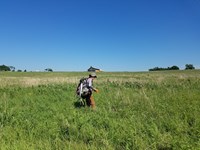- Homestead National Historical Park
Vegetation Community Monitoring at Homestead National Historical Park
- Homestead National Historical Park
Carbon Based Lifeforms Detected At Homestead National Historical Park
- Type: News
- Locations: Homestead National Historical Park
- Date Released: 2019-07-18
Explore the unique prairie plant universe and learn how these carbon based lifeforms thrive in their environment and impacted homesteaders! On Saturday, July 27 from 10 a.m. to 12 p.m. at Homestead’s Education Center discover the mysterious world of the plants of the tallgrass prairie. The Carbon Based Lifeforms Detected program will be followed by a take-home craft activity.
- Type: Article
- Locations: Herbert Hoover National Historic Site, Homestead National Historical Park, Pipestone National Monument
- Offices: Heartland Inventory & Monitoring Network

Herbert Hoover National Historic Site, Homestead National Historical Park, and Pipestone National Monument all protect tallgrass prairie communities. We monitor the plants in these parks to understand how the prairies may be changing over time. Analyzing data from all three parks together helps managers understand how similar management actions at other parks are affecting prairie maintenance. Pipestone National Monument prairies have some unique geology that makes the plant
- George Washington Carver National Monument
Prairie Community Monitoring at George Washington Carver National Monument
- Type: Article
- Locations: George Washington Carver National Monument

Prairies and savannas were common where George Washington Carver spent his childhood in Southwest Missouri but now less than 1% of Missouri's tallgrass prairie remains. George Washington Carver National Monument reconstructed tallgrass prairie on the park in 1985 and uses prescribed burns, mowing, and herbicides to maintain the prairie. The restored prairie is doing well and the diversity of plant species hasn't changed very much over time.
- Tallgrass Prairie National Preserve
Prairie Plant Community Monitoring at Tallgrass Prairie National Preserve
- Type: Article
- Locations: Tallgrass Prairie National Preserve

The Heartland Inventory and Monitoring Program monitors prairie plant communities at Tallgrass Prairie National Preserve. Managers use prescribed fire and grazing treatments to maintain healthy tallgrass prairie and conserve greater prairie-chickens on the park. Monitoring prairies helps managers evaluate management actions and understand how the prairies may be changing over time.
- Wilson's Creek National Battlefield
Prairie Plant Community Monitoring at Wilson's Creek National Battlefield
- Type: Article
- Locations: Wilson's Creek National Battlefield

Restoration of Wilson's Creek National Battlefield prairies began in the 1970s. Prescribed fire, mowing, and herbicide treatments help maintain prairie plant communities at the park. The Heartland Inventory and Monitoring Network monitors the restored prairies to help park managers understand how the prairies may be changing over time.
- Tallgrass Prairie National Preserve
Flint Hills Tallgrasses
- Type: Article
- Locations: Tallgrass Prairie National Preserve
- Grant-Kohrs Ranch National Historic Site
Checking Grant-Kohrs Ranch's Vital Signs
- Type: Article
- Locations: Grant-Kohrs Ranch National Historic Site

In 2007, the Rocky Mountain Inventory and Monitoring Network—a small team of NPS scientists—began monitoring natural resources, called “vital signs,” in Grant-Kohrs Ranch and nearby park units. Vital signs indicate park health and serve as red flags if conditions deteriorate, supporting park managers’ efforts to make science-based management decisions. Learn about the NPS Inventory and Monitoring Division and its work in Grant-Kohrs Ranch National Historic Site.
- Pipestone National Monument
Prairie Plant Community Monitoring at Pipestone National Monument
- Type: Article
- Locations: Pipestone National Monument

There are three prairie types at Pipestone National Monument, including a rare type called Sioux quartzite prairie. We monitor the park prairies to understand how they might be changing over time and to evaluate the effectiveness of park management efforts—like prescribed fire—in maintaining healthy prairies.
Last updated: July 26, 2023



